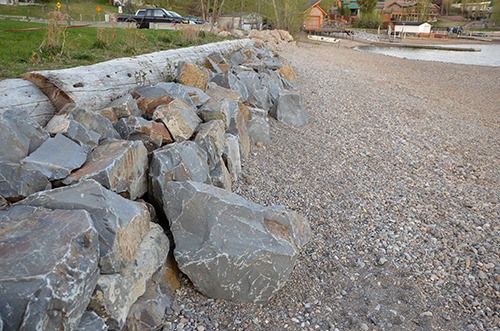Invermere’s shoreline restoration project on Kinsmen Beach has finally been completed.
The nonprofit Lake Windermere Ambassadors group and the district of Invermere started working on the project last year, and the final pieces of it were put in place last week by Peter Pankovitch, owner of local landscaping company Planscape.
“We were losing a significant portion of the beach to erosion,” said Invermere director of development services Rory Hromadnik. “It had progressed back numerous metres.”
Not only was the project important to keep a popular public space from degrading, but it was also a good idea environmentally since tree roots and gravel were starting to interfere with fish spawning habitat, said Mr. Hromadnik.
The rate of erosion had been accelerating.
“We need to look at long-term management of shorelines,” said Lake Windermere Ambassadors’ program co-ordinator Kirsten Harma. “They are the filter for everything that happens when the land and water meet.”
When shorelines lose vegetation, they tend to erode more quickly, and fish and wildlife habitat is lost, she said. This was the case at Kinsmen Beach.
“The shoreline was eroded, tree roots were sticking out,” said Ms. Harma.
Exposed roots are definitely bad, both for the trees and for beach users, according to Mr. Hromadnik.
“It becomes a bit of a safety risk, but mostly it’s erosion and we were losing our beach,” he said.
The Ambassadors, together with the East Kootenay Integrated Lake Management Partnership, conducted a scientific survey of the shoreline around Lake Windermere in 2010. They found that most of the lake’s shoreline was in moderate habitat condition, but with some restoration work could easily be upgraded to good habitat condition.
The Kinsmen Beach restoration work is essentially a pilot project to that end.
Estimating the cost of the project is hard, since many people provided services in-kind, but it likely is roughly $15,000 to $20,000, said Mr. Hromadnik.
According to Ms. Harma, the project is a good demonstration that large, ugly bulkheads (seawalls) are not needed to protect against shoreline erosion. Rather a mix of natural materials such as rocks, logs and vegetation can be used to create something that is not only better environmentally, but is also more aesthetically pleasing.
The East Kootenay Integrated Lake Management Partnership has already gone on to do scientific surveys on nine other lakes in the region.
“I just think its important,” said Mr. Pankovitch, who donated rocks and some of his time to the Kinsmen Beach project.
Ms. Harma said she hopes more vegetation will be added in the future as roots and plants are useful not just for soil stability, but can also help filter water. Eventually there will be an interpretive sign, explaining the feature, she said, but in the meantime asks that the public not trample what’s there.
